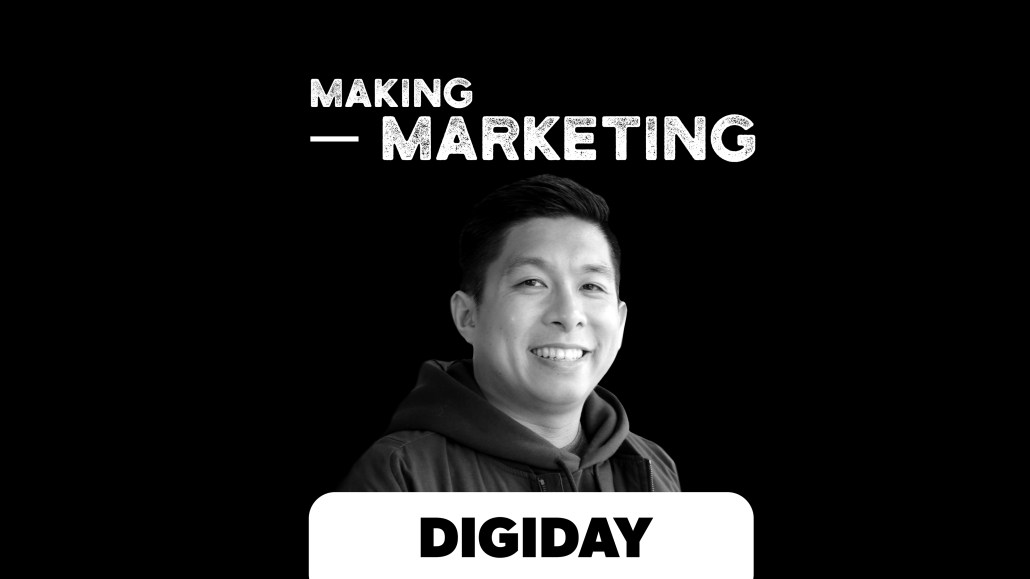‘How Hill City affects Gap Inc. is TBD’: Eric Toda on incubating a brand within a retailer

Subscribe: iTunes | Google Play | Stitcher | RSS | Anchor
Late last year, Gap Inc. launched Hill City, an activewear line that is its version of Athleta, but for men.
It’s also the retail giant’s new opportunity to keep growing in activewear. Eric Toda, head of marketing at Hill City, says the advantages of launching Hill City are to be seen for Gap but in the meantime, there’s a lot Hill City is learning from the retailer.
Created as a “secret brand” within Gap, Hill City only sells on its own site, with some items displayed in about Athleta stores around the country. For now, there are no plans for Hill City to open its own stores.
Ad position: web_incontent_pos1
“Building the brand with Gap meant [Hill City] feels established,” Toda said on the latest episode of Making Marketing. “It wasn’t flopping around. It continues to win. How it affects Gap Inc. is TBD. There’s so many learnings we’re getting right now like how do we change the website, the navigation, placing different products across the site. That will be beneficial. Bigger companies are burying innovation and smaller companies. Gap saw they have leverages internally.”
Host Shareen Pathak sat down with Toda to discuss customer engagement loops, chatbot technology and more. Edited highlights below:
Engaging consumers in the feedback loop.
When we were building Hill City, we thought about what is our point of view in a crowded market and how we should reach our customer and build our brand with them. Many new brands prototype their products [by testing them on] a group of friends. They ask the friends what they liked, what they would change about it. We decided to invite people, getting their feedback and problem-solving with them. Our iterations are better and more comfortable. We have a little under 30,000 applicants [for feedback].
Ad position: web_incontent_pos2
Chatbots are still relevant.
Chatbots never left. It’s about seeing what a practical application of technology looks like versus what’s always been done. Chatbots offer us a lot of scale. They automate a lot of our conversations with our growing community and we can just spot trends. It allows us to scale out our product creation process. People are passionate about giving us feedback.
Instagram is fertile ground for DTC brands.
Instagram is really visual. Storytelling has become more visual than text. I look at the brands that are prolific on Instagram and people are very engaged. When we looked at it, we didn’t want to repurposed TV spots. When we do something on the platform, we do something that we would ourselves. It’s extremely lightweight but that relieves a lot of pressure to engage. You build a presence that is really authentic. Paid [marketing] helps in an acquisition, which is important for any direct-to-consumer brands. But there’s a place for organic, which we also use for acquisition.
More in Marketing

In the marketing world, anime is following in the footsteps of gaming
As marketers look to take advantage of anime’s entry into the zeitgeist, they might be wise to observe the parallels between the evolution of anime as a marketing channel and the ways brands have learned to better leverage gaming in recent years.

With the introduction of video ads and e-commerce, Roblox looks to attain platform status
Roblox is expanding into more areas than just ads in 2024. Much like platforms such as Amazon and Facebook have transcended their origins to evolve from their origins as online marketplaces and social media channels, Roblox is in the midst of a transformation into a platform for all elements of users’ virtual lives.

PepsiCo wants to remain a ‘driver of culture’ as it turns to influencers and activations amid rebrand
The soda-maker says it can translate cultural relevance into sales volume.
Ad position: web_bfu



